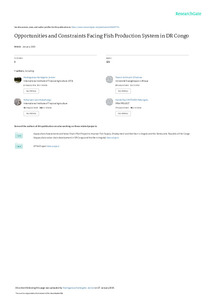| dc.contributor.author | Mushagalusa, N.J. |
| dc.contributor.author | Zihalirwa, P. |
| dc.contributor.author | Ngangura, O. |
| dc.contributor.author | Safari, M. |
| dc.contributor.author | Nabahungu, N.L. |
| dc.contributor.author | Matungulu, K.P. |
| dc.contributor.author | Okafor, C. |
| dc.date.accessioned | 2022-09-08T09:02:03Z |
| dc.date.available | 2022-09-08T09:02:03Z |
| dc.date.issued | 2019-12 |
| dc.identifier.citation | Mushagalusa, N.J., Zihalirwa, P., Ngangura, O., Safari, M., Nabahungu, N.L., Matungulu, K.P. & Okafor, C. (2019). Opportunities and constraints facing fish production system in DR Congo. International Journal of Innovative Science and Research Technology, 4(12), 631-640. |
| dc.identifier.issn | 2456-2165 |
| dc.identifier.uri | https://hdl.handle.net/20.500.12478/7720 |
| dc.description.abstract | The current aquaculture production systems in the village environment and their constraints and opportunities were studied to understand the reasons for the decrease in the number of fishponds in South Kivu, eastern DR Congo. . Little is known about fish production in South Kivu; thus, this study was carried out in two phases: a survey, a follow-up of the farms over the course of a year and a literature review. Accordingly, 305 aquaculturists from three territories were interviewed from May to November 2019. This breeding is mainly practiced by men (91.6%), adults (45±14 years), married (93.6%), fish farmers with no formal education (36.5%, ) farmers who practice agriculture as their main activity (68.5%, ) and farmers engaged in fish farming as a secondary activity (60.4%). Fish farmers have 13±9 years' experience; and only 39.0 percent of fish farmers received training on good fish farming practices. Membership to groups or associations is low (6.1%). Tilapia sp is the widely cultivated species (82.6%), followed by a combination of Tilapia-Catfish (17.3%). Fish are reared in medium-sized fishponds (358.7±230.4 m2) at unknown age (60.4%), with a reproduction rate of (54.7±37.7 kg) per growth cycle. The main opportunities in aquaculture in South Kivu are water availability (13.5% in Kabare, 31.1% in the Ruzizi plain, and 15.3% in Walungu), the presence of a fish market, and availability of land suitable for aquaculture (27.1% in Kabare, 10.9% in the plain, and 15.3% in Walungu). On the other hand, the main constraints identified are lack of quality fry (75.5% in Kabare) and the high cost of labour (60.9% in the Ruzizi plain and 60.9% in Walungu). |
| dc.format.extent | 631-640 |
| dc.language.iso | en |
| dc.subject | Fish Culture |
| dc.subject | Constraints |
| dc.subject | Sustainability |
| dc.title | Opportunities and constraints facing fish production system in DR Congo |
| dc.type | Journal Article |
| cg.contributor.crp | Roots, Tubers and Bananas |
| cg.contributor.affiliation | International Institute of Tropical Agriculture |
| cg.contributor.affiliation | Universite Evangelique en Afrique |
| cg.coverage.region | Africa |
| cg.coverage.region | Central Africa |
| cg.coverage.country | Democratic Republic of the Congo |
| cg.coverage.hub | Central Africa Hub |
| cg.researchtheme | Natural Resource Management |
| cg.identifier.bibtexciteid | MUSHAGALUSA:2019 |
| cg.authorship.types | CGIAR and developing country institute |
| cg.iitasubject | Agribusiness |
| cg.iitasubject | Farming Systems |
| cg.iitasubject | Socioeconomy |
| cg.journal | International Journal of Innovative Science and Research Technology |
| cg.notes | published online: 27 January, 2020. |
| cg.accessibilitystatus | Open Access |
| cg.reviewstatus | Peer Review |
| cg.usagerightslicense | Creative Commons Attribution 4.0 (CC BY 0.0) |
| cg.targetaudience | Scientists |
| cg.iitaauthor.identifier | Nsharwasi Nabahungu: 0000-0002-2104-3777 |
| cg.iitaauthor.identifier | Kande M PAUL MATUNGULU: 0000-0001-5664-951X |
| cg.iitaauthor.identifier | Chris Okafor: 0000-0003-2162-6101 |
| cg.futureupdate.required | No |
| cg.identifier.issue | 12 |
| cg.identifier.volume | 4 |

